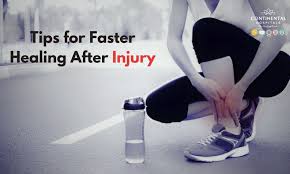
How to Heal Faster After an Injury – Backed by Science
Injuries happen—whether it’s a twisted ankle, muscle strain, or something more serious. What if you could speed up your body’s natural healing process and get back to feeling your best sooner? The good news: science shows that how you care for your injury in the days and weeks after it happens makes a huge difference.
From diet to movement, sleep to mindset, here’s your science-backed guide to healing faster and stronger.
Understanding the Healing Process
When you get injured, your body goes through several stages to repair itself:
-
Inflammation – Your body sends immune cells to protect and clear damaged tissue. This phase usually lasts a few days.
-
Proliferation – New cells grow to rebuild tissue and blood vessels.
-
Remodeling – The new tissue strengthens and matures over weeks to months.
Supporting your body properly during each phase can optimize recovery time and reduce complications like stiffness or re-injury.
1. Prioritize Rest—but Not Total Immobilization
Rest is crucial right after injury to prevent further damage. However, complete immobilization for too long can delay healing and weaken muscles.
Research suggests early, gentle movement—like light stretching or range-of-motion exercises—can improve blood flow and promote faster tissue repair without harming the injury.
Talk to a physical therapist about the right type and timing of movement for your injury.
2. Eat Healing-Boosting Foods
Your body needs specific nutrients to repair damaged tissues and reduce inflammation.
Key nutrients include:
-
Protein: Builds new tissue (lean meats, beans, tofu)
-
Vitamin C: Supports collagen production (citrus fruits, berries, bell peppers)
-
Zinc: Aids immune function and wound healing (nuts, seeds, whole grains)
-
Omega-3 Fatty Acids: Reduce inflammation (fatty fish, flaxseeds, walnuts)
-
Antioxidants: Protect cells from damage (dark leafy greens, colorful fruits)
3. Manage Inflammation Smartly
Inflammation is part of healing but excessive or prolonged inflammation can cause pain and delay recovery.
-
Avoid overusing NSAIDs (like ibuprofen) for long periods; they can interfere with tissue repair if used excessively.
-
Use ice therapy during the first 48 hours to reduce swelling and pain.
-
Elevate the injured area when possible to reduce fluid buildup.
-
After acute inflammation passes, apply heat therapy to increase blood flow and relax muscles.
4. Get Plenty of Quality Sleep
Sleep is when your body does much of its healing and regeneration. Growth hormone—key to tissue repair—is released during deep sleep.
-
Aim for 7 to 9 hours of restful sleep each night.
-
Create a calming bedtime routine and limit screens before bed.
-
If pain disrupts your sleep, talk to your healthcare provider about ways to manage it.
5. Stay Hydrated
Water is essential for delivering nutrients to tissues and flushing out waste products from the injury site.
Dehydration can slow healing and increase fatigue. Make sure to drink enough fluids every day, especially if you’re taking medications that can dehydrate you.
6. Mind Your Mental Health
Stress, anxiety, and depression can negatively impact your immune system and delay healing.
-
Practice mindfulness or meditation to reduce stress hormones like cortisol.
-
Stay connected with supportive friends and family.
-
Consider professional help if you’re feeling overwhelmed.
7. Use Physical Therapy and Rehabilitation
A guided rehab program helps restore strength, flexibility, and function, reducing the risk of reinjury.
-
Physical therapists use manual therapy, exercises, and modalities like ultrasound or electrical stimulation to support healing.
-
Consistency and gradual progression are key.
8. Avoid Smoking and Limit Alcohol
Both smoking and excessive alcohol consumption impair circulation and reduce your body’s ability to heal wounds and build new tissue.
Quitting smoking and drinking moderately can significantly improve your recovery outcomes.
Final Thoughts
Healing after an injury isn’t just about waiting it out—it’s about actively supporting your body’s incredible repair mechanisms. By combining rest with smart movement, nourishing your body with the right foods, prioritizing sleep, and managing stress, you can speed your recovery and come back stronger.
Remember, everyone heals differently, so listen to your body and seek professional guidance when needed.
Take control of your healing journey today—science is on your side.
